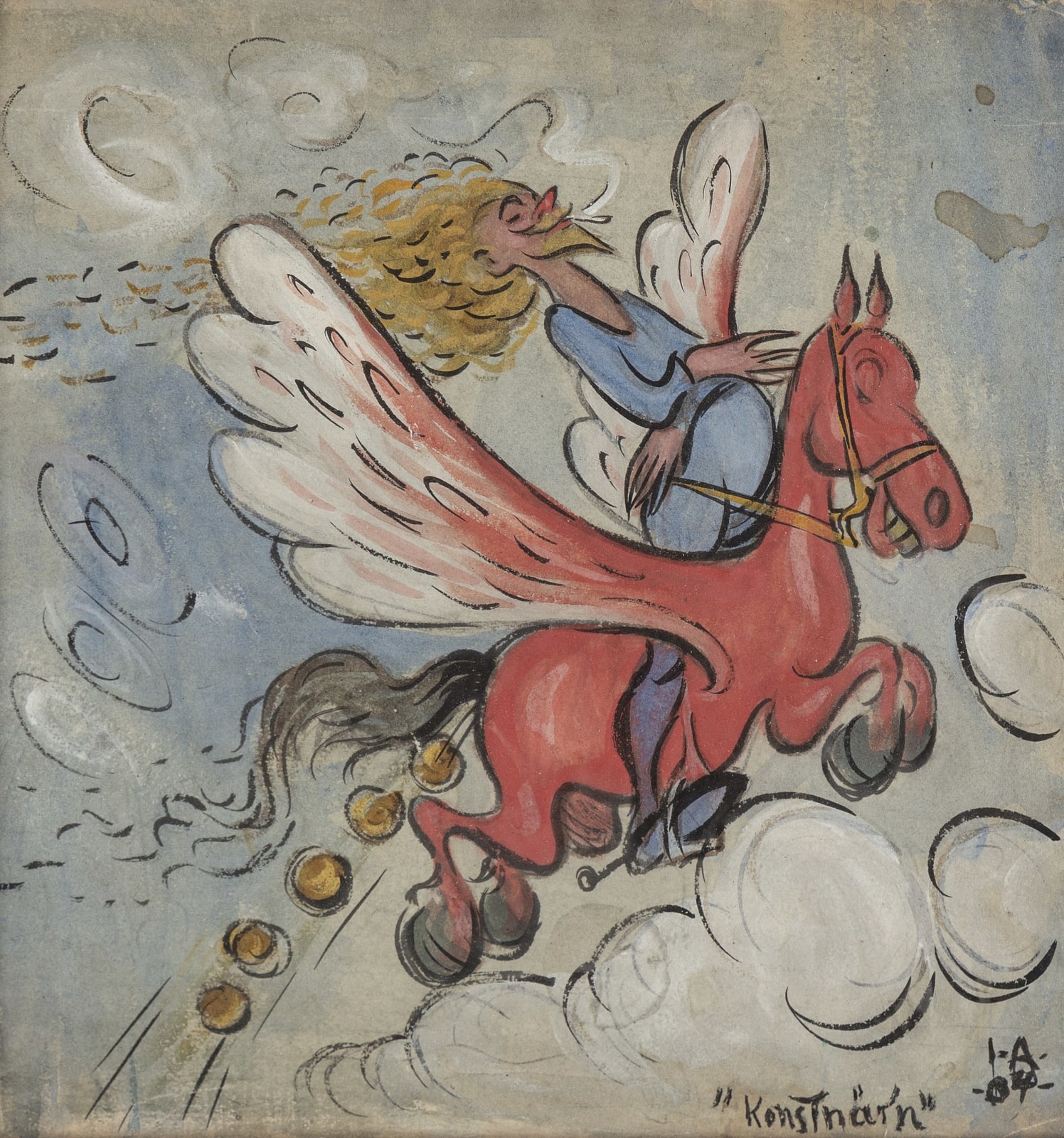Ivar Arosenius Swedish, 1878-1909
The Artist (Konstnär'n) Gerard Henning, 1904
Graphite and watercolour on paper
26.5 x 26.5 cm
10 3/8 x 10 3/8 in
10 3/8 x 10 3/8 in
Clase Fine Art
Further images
Gerhard Henning (27 May 1880 – 16 September 1967) was a Swedish-Danish sculptor. While working at the Royal Danish Porcelain Factory, he designed a number of delicately decorated figurines. He...
Gerhard Henning (27 May 1880 – 16 September 1967) was a Swedish-Danish sculptor. While working at the Royal Danish Porcelain Factory, he designed a number of delicately decorated figurines. He is remembered above all for his statues celebrating the female form. He spent the winter of 1897–98 in Gothenburg. There he met Ivar Arosenius whose friendship greatly influenced his early work as a painter and illustrator.
The winged Pegasus often flies in and out of Arosenius’s images. The artist delights in mocking this iconic figure that usually symbolises, in many different ways, poetry and fantasy. Sometimes it is a protagonist, sometimes it is a bystander somewhere in the background.
In Arosenius’s 1905 painting Kvarnen, a voluptuous Venus drifts away on a Pegasus. In the most important watercolour of 1906, Livet och dess tross (Life and its drag rope), the newlyweds’ carriage is drawn by a Pegasus. It suddenly veers from the staked-out path towards a romantic landscape. In the series of images Ben Onis dröm, the daring lover makes off with the queen on a winged horse. With ferocious speed, they flee to the island of eternal happiness where the horse is left to graze in the grass. A rickety Pegasus, akin to Don Quixote’s skinny Rosinante, is found in the humorous self-portrait in the 1904 watercolour Värdshuset. These and other examples clearly indicate how attached Arosenius was to the symbolically loaded figure of Pegasus.
The present watercolour Konstnär’n (The Artist) is one of these variations on the theme of Pegasus and also a caricature of a successful, boastful artist. Henning rides amongst clouds that may well be dream-bubbles. With his eyes closed, cigarette falling out of his mouth and a nonchalant pose, he is aiming sky high in every sense of the word.
The smiling Pegasus, in fine fettle with its wings spread wide, gallops towards the heavenly realms. Meanwhile its droppings are transformed into gold.
This watercolour, with its diagonal, dynamic composition, the clear colours and the black contour line, is another example of Ivar Arosenius’s characteristic way of working. He conveys a visual humour and can easily transmit an ironic multi-layered tale that remains open to diverse interpretations.
The winged Pegasus often flies in and out of Arosenius’s images. The artist delights in mocking this iconic figure that usually symbolises, in many different ways, poetry and fantasy. Sometimes it is a protagonist, sometimes it is a bystander somewhere in the background.
In Arosenius’s 1905 painting Kvarnen, a voluptuous Venus drifts away on a Pegasus. In the most important watercolour of 1906, Livet och dess tross (Life and its drag rope), the newlyweds’ carriage is drawn by a Pegasus. It suddenly veers from the staked-out path towards a romantic landscape. In the series of images Ben Onis dröm, the daring lover makes off with the queen on a winged horse. With ferocious speed, they flee to the island of eternal happiness where the horse is left to graze in the grass. A rickety Pegasus, akin to Don Quixote’s skinny Rosinante, is found in the humorous self-portrait in the 1904 watercolour Värdshuset. These and other examples clearly indicate how attached Arosenius was to the symbolically loaded figure of Pegasus.
The present watercolour Konstnär’n (The Artist) is one of these variations on the theme of Pegasus and also a caricature of a successful, boastful artist. Henning rides amongst clouds that may well be dream-bubbles. With his eyes closed, cigarette falling out of his mouth and a nonchalant pose, he is aiming sky high in every sense of the word.
The smiling Pegasus, in fine fettle with its wings spread wide, gallops towards the heavenly realms. Meanwhile its droppings are transformed into gold.
This watercolour, with its diagonal, dynamic composition, the clear colours and the black contour line, is another example of Ivar Arosenius’s characteristic way of working. He conveys a visual humour and can easily transmit an ironic multi-layered tale that remains open to diverse interpretations.






